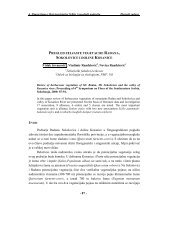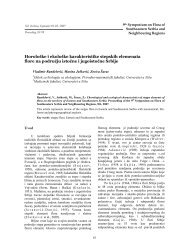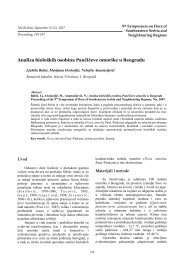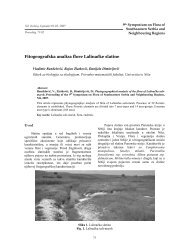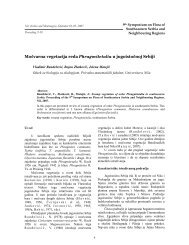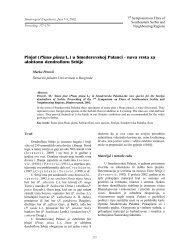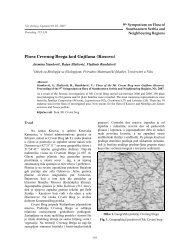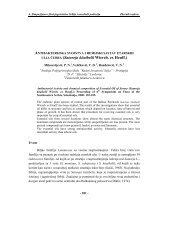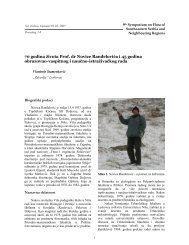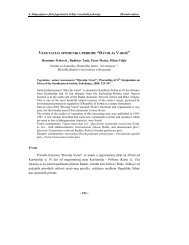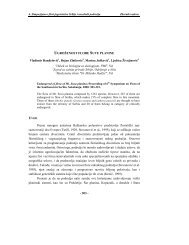10th Symposium on the Flora of Southeastern Serbia and ...
10th Symposium on the Flora of Southeastern Serbia and ...
10th Symposium on the Flora of Southeastern Serbia and ...
You also want an ePaper? Increase the reach of your titles
YUMPU automatically turns print PDFs into web optimized ePapers that Google loves.
10 th <str<strong>on</strong>g>Symposium</str<strong>on</strong>g> <strong>on</strong> <strong>the</strong> <strong>Flora</strong> <strong>of</strong> Sou<strong>the</strong>astern <strong>Serbia</strong> <strong>and</strong> Neighbouring regi<strong>on</strong>s,Vlasina 17 to 20 June 2010The Family Boletaceae s.l. (Excluding Boletus) in <strong>the</strong>Republic <strong>of</strong> M<strong>on</strong>tenegroKasom, G.Institute for <strong>the</strong> Protecti<strong>on</strong> <strong>of</strong> Nature <strong>of</strong> M<strong>on</strong>tenegro, M<strong>on</strong>tenegrogkasom@t-com.meThe Family Boletaceae s.l. (Excluding Boletus) in <strong>the</strong> Republic <strong>of</strong>M<strong>on</strong>tenegro This paper c<strong>on</strong>tains results <strong>of</strong> systematic research into Boletaceae s.l.(excluding Boletus L.) in <strong>the</strong> Republic <strong>of</strong> M<strong>on</strong>tenegro. 45 species bel<strong>on</strong>ging to 18genera are presented. One genus <strong>and</strong> three species are reported for <strong>the</strong> first timefrom M<strong>on</strong>tenegro. For each species, <strong>the</strong> published <strong>and</strong> unpublished sources <strong>of</strong> dataare given, as well as <strong>the</strong> collecti<strong>on</strong>s in which <strong>the</strong> material is deposited. Also, <strong>the</strong>review <strong>of</strong> macr<strong>of</strong>ungi with nati<strong>on</strong>al <strong>and</strong> internati<strong>on</strong>al significance is given.Genetic <strong>and</strong> morphological diversity <strong>of</strong> closely relatedSphagnum angustifolium, S. fallax <strong>and</strong> S. flexuosumSzurdoki, E. 1 , Szövényi, P. 2 , Major, A. 11 Hungarian Natural History Museum, Budapest, Hungary2 University <strong>of</strong> Freiburg, Freiburg, Germanyszurdoki@bot.nhmus.huWe are investigating genetic <strong>and</strong> morphological diversity <strong>of</strong> Hungarian <strong>and</strong>European S. angustifolium, S. fallax <strong>and</strong> S. flexuosum populati<strong>on</strong>s. We are utilizingten microsatellite loci <strong>and</strong> five sequencing primer to evaluate <strong>the</strong> tax<strong>on</strong>omicvalue/rank <strong>of</strong> <strong>the</strong> investigated species. Morphological measurements are held <strong>on</strong>spreading <strong>and</strong> hanging branches, stem leaves, pendent <strong>and</strong> spreading branch leaves.At present we are in <strong>the</strong> process <strong>of</strong> generating microsatellite pr<strong>of</strong>iles for 200specimens distributed across <strong>the</strong> distributi<strong>on</strong> range <strong>of</strong> <strong>the</strong> species in Europe. Untilnow we analysed microsatellite loci <strong>on</strong> 100 samples, from 14 countries (next 100samples are in progress). Most markers showed high variability <strong>and</strong> thus appear tobe appropriate to study <strong>the</strong> relati<strong>on</strong>ship <strong>of</strong> <strong>the</strong> closely related species. Although <strong>the</strong>rewere alleles specific to each <strong>of</strong> <strong>the</strong> three species <strong>the</strong> majority <strong>of</strong> <strong>the</strong> alleles are sharedam<strong>on</strong>g <strong>the</strong>m c<strong>on</strong>firming <strong>the</strong>ir close genetic relatedness. To see whe<strong>the</strong>r accessi<strong>on</strong>s<strong>of</strong> <strong>the</strong> three described morphological species comprise distinct genetic entitiespairwise genetic distances were subjected to multivariate analysis (PCOA). ThePCOA suggest that two <strong>of</strong> <strong>the</strong> three pairwise species comparis<strong>on</strong> (S. fallax vs. S.flexuosum <strong>and</strong> S fallax vs. S. angustifolium) are well separated from each o<strong>the</strong>r21



